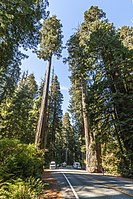
Photo from wikipedia
Abstract Mature second-growth coast redwood (Sequoia sempervirens) forests—logged over 100 yr ago—are an important resource in the redwood region, but development of regenerating forests beyond rotation age (~50 yr) is not well… Click to show full abstract
Abstract Mature second-growth coast redwood (Sequoia sempervirens) forests—logged over 100 yr ago—are an important resource in the redwood region, but development of regenerating forests beyond rotation age (~50 yr) is not well understood. Continuous long-term data are especially lacking, considering that the maximum possible age of second-growth stands is over 160 yr. Here we examine accumulation of tree biomass, leaf area, and canopy structure in three mature second-growth forests in California (Arcata, Big River, Oakland) that range in age from 133 to 159 yr since clearcut logging. Four fixed-area plots form the basis of this examination, including three 1-acre plots established in 1923 that together permit examination of Sequoia forest development over nearly a century. The four plots held 963 to 1476 Mg ha−1 of aboveground tree biomass and 9.0 to 13.7 of tree leaf area index. From 1923 to 2017, the Big River plot exhibited rapid biomass accumulation (up to 23 Mg ha−1 yr−1) as a densely stocked nearly pure Sequoia stand on an alluvial terrace. The two low-elevation plots near Arcata exhibited slower (up to 13 Mg ha−1 yr−1) but consistent growth with an increasing dominance of Sequoia, as co-occurring conifers (Abies grandis, Picea sitchensis, Pseudotsuga menziesii) steadily declined in number despite rapid early growth. Increasing Sequoia dominance, substantial density-independent mortality in recent decades, and shifts in tree size distributions illustrate structural maturation as these forests approach an old-growth condition. The Oakland plot, which occurred ~ 300 m higher in elevation and received less than two-thirds as much annual rainfall, was a nearly pure Sequoia stand with canopy structure similar to, but shorter than, the Big River plot. Despite differences in elevation and rainfall, aboveground biomass of individual large trees in all four plots exceeded 15 Mg with Sequoia biomass increments averaging > 200 kg yr−1 during the 21st century. Characteristics and developmental trajectories of these plots provide realistic benchmarks for management of alluvial, upland, and inland Sequoia forests.
Journal Title: Forest Ecology and Management
Year Published: 2020
Link to full text (if available)
Share on Social Media: Sign Up to like & get
recommendations!